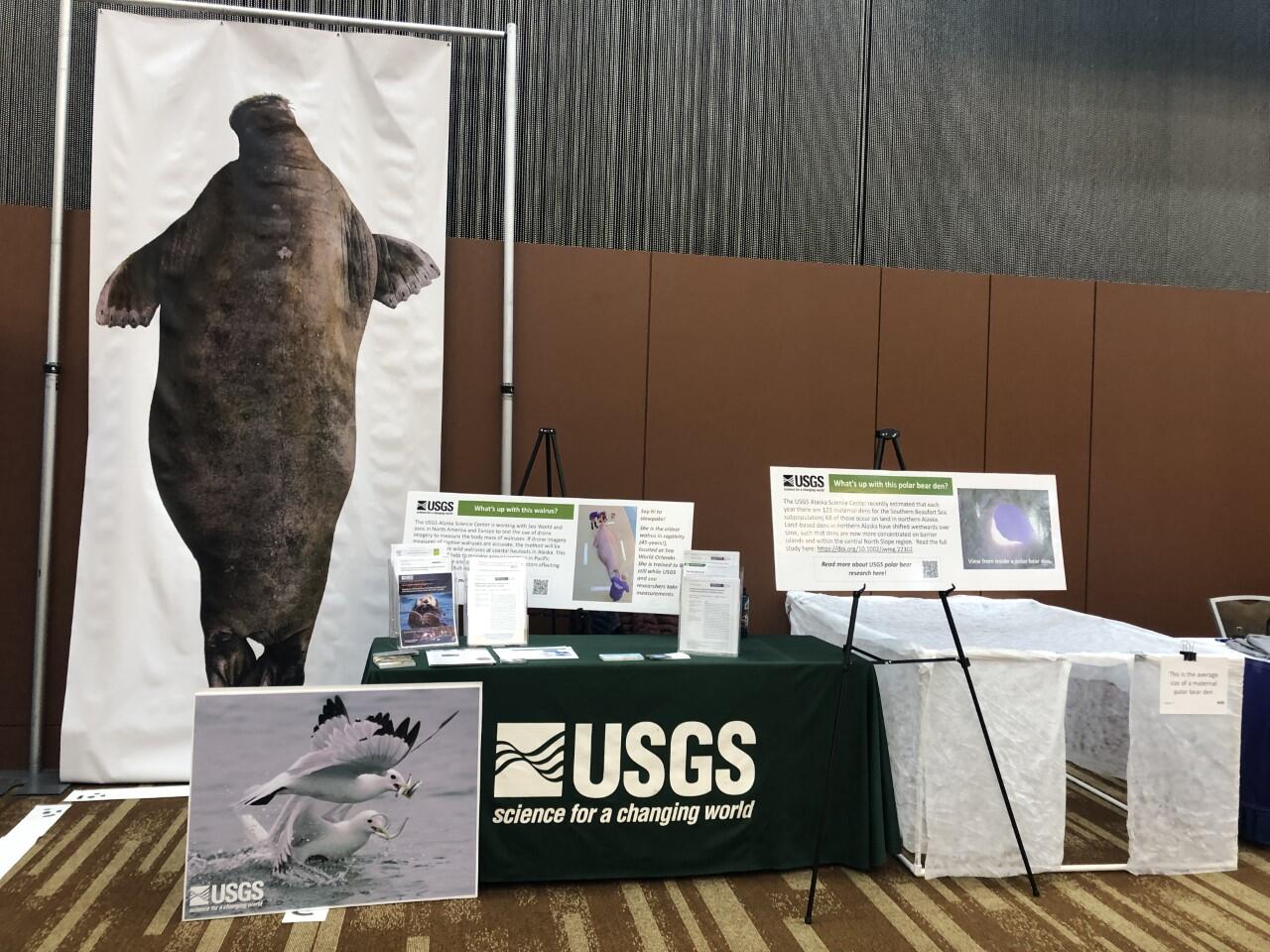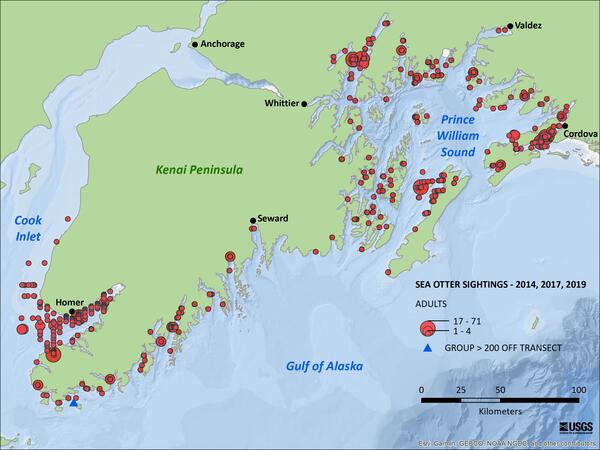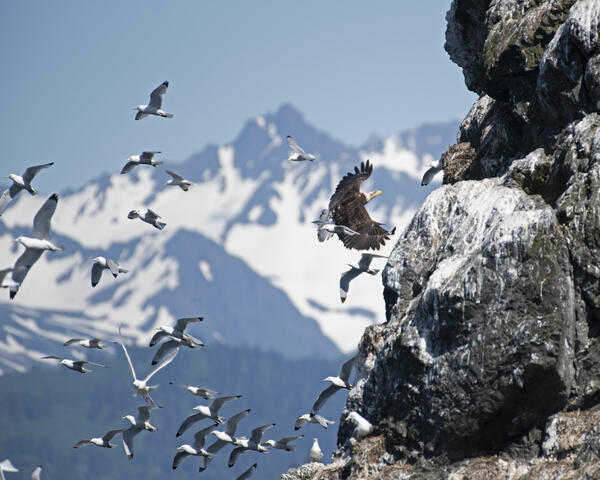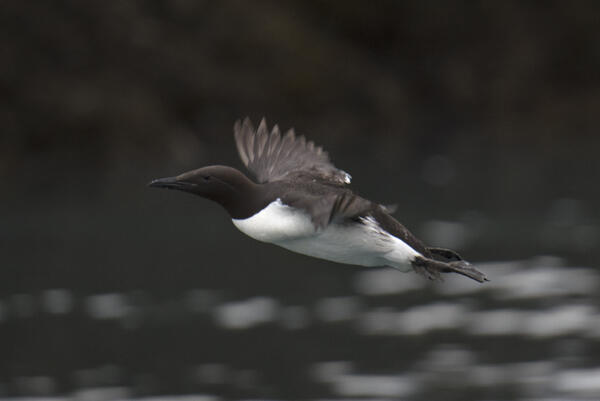Q&A: Marine Ecosystems Research at the USGS Alaska Science Center
The USGS Alaska Science Center is a leader and collaborator in marine ecosystems research on topics ranging from ocean bottom-dwelling invertebrates and small pelagic forage fish (food for Pacific walrus, sea otters, and marine birds) to polar bears (an apex predator in the Arctic). Here, we highlight current research by the USGS Alaska Science Center that focuses on marine ecosystems of Alaska.
Each January, the Alaska Marine Science Symposium takes place in Anchorage, Alaska. The meeting provides a forum for sharing recent marine science information from the Gulf of Alaska, Aleutian Islands and Bering Sea, and Arctic regions of Alaska. In this Q&A, we summarize recent marine ecosystems research that the USGS Alaska Science Center has conducted over the past year. To keep up with all the latest USGS research news, check out the Weekly Findings page.

Return to USGS Alaska Q&A Series
Arctic Region – New findings in 2024
Polar bears: The USGS routinely produces forecasts of wildlife populations and ecosystems to inform management agencies of likely future conditions. An updated circumpolar population model for polar bears found that polar bear populations will continue to experience increasing probability of decline throughout the 21st century, consistent with the previous two model generations. Additional findings for polar bears including the following:

- Identifying ecological indicators of polar bear population status (more here)
- Sea-ice conditions predict polar bear land use around military installations in Alaska (more here)
- The post-emergence period for denning polar bears: phenology and influence on cub survival (more here)
- Potential impacts of an autumn oil spill on polar bears summering on land in northern Alaska (more here)
- Increased pathogen exposure in polar bears over three decades (more here)
- Polar bear energetic and behavioral strategies on land with implications for surviving the ice-free period (more here)
Pacific walrus: Declines in Arctic sea ice continues to lead to large haulouts of walrus in coastal area of Alaska and Russia. The USGS is using drone and satellite imagery to quantify herd abundance, dynamics, and body condition when walruses are onshore at these haulouts. Working with walruses in human care, USGS has developed methods to determine walrus body condition from drone imagery.
Coastal fish: The USGS completed a study on how Arctic coastal fish community composition varies with environmental drivers, such as temperature, salinity and wind conditions. This work provides data on fish spatial distributions to inform subsistence and other anthropogenic use. A USGS study also quantified the age of carbon in Arctic fish as another metric of thawing permafrost and a changing Arctic.
Arctic Region – Ongoing work in 2025

Polar bears: The USGS continues to work with Indigenous, U.S., and Canadian collaborators on an updated abundance estimate for the Southern and Northern Beaufort Sea subpopulations of polar bears. The new estimate is expected in late 2025. The USGS is also working on an assessment of the combined influence of biotic and anthropogenic stressors on polar bears to inform circumpolar conservation planning. Lastly, USGS is collaborating on a study that estimates ages of polar bears in the Chukchi and Southern Beaufort subpopulations based on an epigenetic DNA methylation clock.
Pacific walrus: A third year of cruises will take place in 2025 in the Bering and Chukchi seas to estimate the population size and trend of Pacific walrus and aerial drone work will be conducted by USGS in northwestern Alaska to monitor body condition.
Coastal fish and loons: The USGS will summarize data collected as part of a Bureau of Ocean Energy Management-funded study on coastal Arctic marine fish communities on the productivity of red-throated loons, a species in decline on the North Slope of Alaska. The USGS is also assessing habitat use of loons in the western portion of the Arctic National Wildlife Refuge.
Aleutian and Bering Sea Region – New findings in 2024

Pacific salmon: Chinook salmon in western Alaska occupy the northern extent of their species' range and are experiencing prolonged declines in abundance resulting in fisheries closures and impacts to the well-being of Indigenous people and local communities. The USGS collaborated on a study that estimated the effects of environmental indicators, body size, and other metrics on the productivity of 26 Chinook salmon populations. These results demonstrate for the first time that declines in body size of Chinook salmon in western Alaska were associated with declining population productivity.
Eelgrass: The USGS released a preprint of a study that updated maps of eelgrass distribution at Izembek Lagoon, Alaska, using Sentinel-2 optical satellite imagery. The study also quantified how much change has taken place in the extent of eelgrass in the lagoon between 2006 and 2020.

Aleutian and Bering Sea Region – Ongoing work in 2025
Sea Otter Distribution: Sea otters in the southwest region of Alaska (including the north side of the Alaska Peninsula and in Bristol Bay) are listed as
threatened under the Endangered Species Act. In 2025, USGS plans to facilitate community workshops about historical and contemporary sea otter abundance and distribution in the region. USGS also will coordinate a collaborative survey of sea otters to comprehensively survey the north coast of the Alaska Peninsula and Bristol Bay.
Gulf of Alaska Region – New findings in 2024

Glaciers and Nearshore Fish: Glaciers impact nearshore marine ecosystems through the discharge of cold and fresh waters and nutrients and organic matter. A study in 2024 examined five adjacent estuaries in the northern Gulf of Alaska (Kachemak Bay) to test whether differences in glaciers upstream of estuaries affect nearshore fishes.
Forage Fish: The USGS released information from 11 years of aerial shoreline forage fish surveys in Prince William Sound. This long time series highlight changes in Pacific herring and Pacific sand lance school density in nearshore habitats. USGS and collaborators also used seabird diets on Middleton Island to track trends in forage fish populations over time. Capelin populations collapsed from record high abundances during the 2007-2013 cool period to record low abundances in 2016, during the Pacific marine heatwave. Both capelin and Pacific sand lance occurred in seabird diets less often during 2014-2022, but after ocean temperatures cooled in 2023, we began to see signs of capelin stock recovery.
Seabirds: The USGS continues to demonstrate lingering impacts from the 2014-2016 Pacific marine heatwave on seabirds in the Gulf of Alaska. One study found declines in seabird reproductive success and abundance at colonies. In another study, USGS researchers found evidence for an additional stressor: bald eagle disturbance to nesting colonies. In years when disturbance levels were high and persisted later in the season, seabird nesting colonies experienced complete breeding failures due to disturbance-associated egg depredation by gulls.

Gulf Watch Alaska: The Pacific marine heatwave of 2014–2016 was a long-lasting temperature disturbance that occurred throughout the North Pacific region. A USGS-led study in 2024 found that there was little evidence of a direct effect of the marine heatwave on coastal barnacle life stages. Additionally, USGS collaborated on a study on how macroalgae and phytoplankton support the base of highly productive nearshore ecosystems. The study considered four regions in the northern Gulf of Alaska and the results suggest that macroalgae is likely more important to cold-temperate nearshore food webs than phytoplankton.
Sea otters: As sea otters re-occupy their former range following near extirpation during the fur trade, they can have profound top-down effects on nearshore marine communities. USGS has tracked sea otter occupation of Glacier Bay, and associated nearshore responses, since 1993. USGS collaborated on a recent paper describing changes in sea otter prey type and size class through the reoccupation process.
Gulf of Alaska Region – Ongoing work in 2025

Lower Cook Inlet: USGS continues work on benthic fish and invertebrate distribution and abundance in lower Cook Inlet that can be used to support a multi-species ecosystem model.
Gulf Watch Alaska: USGS and collaborators continue to conduct marine monitoring in the Gulf of Alaska, as part of the Gulf Watch Alaska program. The USGS is playing a leading role in pelagic and nearshore marine ecosystem monitoring, data distribution, and synthesis efforts.
Sea otters: USGS and partners continue to develop photo-based aerial survey methods and integrated data models for better understanding changes in distribution and abundance of sea otters at the request of the Bureau of Ocean Energy Management.
Across All Regions – New findings in 2024
Seabirds: The USGS led a synthesis of the impact of marine heatwaves on seabirds in Alaska and beyond in an introduction to a Theme Section in the journal Marine Ecology Progress Series. This Theme Section, inspired by a symposium at the 3rd World Seabird Conference, discusses mechanisms by which marine heatwaves impact seabirds.

Seabirds and Marine Mammals: The North Pacific Pelagic Seabird Database (NPPSD) is maintained by the USGS ASC and houses over 50 years of at-sea survey transect data for seabirds and marine mammals across Alaska and throughout the North Pacific Ocean. In order to facilitate the visualization and use of NPPSD data, the USGS developed an R Shiny application with an interactive leaflet map.
Alongside collaborators, the USGS published a magazine article intended for a lay audience about how seabirds and marine mammals gave early warning signals during the 2014-2016 Pacific marine heatwave. This unprecedented heatwave affected nearshore and pelagic ecosystems from Alaska to California.
Harmful Algal Bloom (HAB) Toxins: The USGS Alaska Science Center maintains HAB toxin testing capabilities and has provided our collaborators with assessments of toxins in seabird, fish, invertebrate and plankton samples. Ongoing research includes examining the distribution and concentration of these toxins in marine food webs, in seabirds, as well as investigating the effects of paralytic shellfish toxins on seabird behavior and health during experimental studies.
Forage Fish: With data from many collaborators, the USGS produced and hosted the Alaska Forage Fish Database (AFFD) to support science information needs at the Bureau of Ocean Energy Management. Information from the AFFD can inform oil spill risk assessments and spatial planning for energy development in Alaska Outer Continental Shelf Region.
ASC Walrus Thematic Data Releases
Harmful Algal Bloom Toxins in Alaska Seabirds
Walrus Research
Polar Bear Research
Nearshore Marine Ecosystem Research
Detecting Long-term Changes in Forage Fish Populations in Prince William Sound, Alaska
North Pacific Pelagic Seabird Database
Q&A: Vessel Expedition for Estimates of Pacific Walrus Demography
Assessing heat stress in migrating Yukon River Chinook Salmon
Seabirds and Forage Fish Ecology
Alaska Forage Fish Database
Pacific Marine Heatwave
Photogrammetry-based body condition for monitoring an Arctic marine mammal experiencing habitat loss Photogrammetry-based body condition for monitoring an Arctic marine mammal experiencing habitat loss
Planktonic to sessile: Drivers of spatial and temporal variability across barnacle life stages and indirect effects of the Pacific Marine Heatwave Planktonic to sessile: Drivers of spatial and temporal variability across barnacle life stages and indirect effects of the Pacific Marine Heatwave
Increased pathogen exposure of a marine apex predator over three decades Increased pathogen exposure of a marine apex predator over three decades
Body size and early marine conditions drive changes in Chinook salmon productivity across northern latitude ecosystems Body size and early marine conditions drive changes in Chinook salmon productivity across northern latitude ecosystems
Arctic fishes reveal patterns in radiocarbon age across habitats and with recent climate change Arctic fishes reveal patterns in radiocarbon age across habitats and with recent climate change
Mapping eelgrass cover and biomass at Izembek Lagoon, Alaska, using in-situ field data and Sentinel-2 satellite imagery Mapping eelgrass cover and biomass at Izembek Lagoon, Alaska, using in-situ field data and Sentinel-2 satellite imagery
Capelin on the rebound: Using seabird diets to track trends in forage fish populations Capelin on the rebound: Using seabird diets to track trends in forage fish populations
Relative importance of macroalgae and phytoplankton to nearshore consumers and growth across climatic conditions in the northern Gulf of Alaska Relative importance of macroalgae and phytoplankton to nearshore consumers and growth across climatic conditions in the northern Gulf of Alaska
Mechanisms by which marine heatwaves impact seabirds Mechanisms by which marine heatwaves impact seabirds
Does the extent of glacial cover across watersheds and discharge periods affect dietary resource use of nearshore fishes in the Northern Gulf of Alaska? Does the extent of glacial cover across watersheds and discharge periods affect dietary resource use of nearshore fishes in the Northern Gulf of Alaska?
Local environmental conditions structured discrete fish assemblages in Arctic lagoons Local environmental conditions structured discrete fish assemblages in Arctic lagoons
Predator disturbance contributed to Common Murre Uria aalge breeding failures in Cook Inlet, Alaska following the 2014–2016 Pacific marine heatwave Predator disturbance contributed to Common Murre Uria aalge breeding failures in Cook Inlet, Alaska following the 2014–2016 Pacific marine heatwave
North Pacific Pelagic Seabird Database Visualization Tool North Pacific Pelagic Seabird Database Visualization Tool
The USGS Alaska Science Center is a leader and collaborator in marine ecosystems research on topics ranging from ocean bottom-dwelling invertebrates and small pelagic forage fish (food for Pacific walrus, sea otters, and marine birds) to polar bears (an apex predator in the Arctic). Here, we highlight current research by the USGS Alaska Science Center that focuses on marine ecosystems of Alaska.
Each January, the Alaska Marine Science Symposium takes place in Anchorage, Alaska. The meeting provides a forum for sharing recent marine science information from the Gulf of Alaska, Aleutian Islands and Bering Sea, and Arctic regions of Alaska. In this Q&A, we summarize recent marine ecosystems research that the USGS Alaska Science Center has conducted over the past year. To keep up with all the latest USGS research news, check out the Weekly Findings page.

Return to USGS Alaska Q&A Series
Arctic Region – New findings in 2024
Polar bears: The USGS routinely produces forecasts of wildlife populations and ecosystems to inform management agencies of likely future conditions. An updated circumpolar population model for polar bears found that polar bear populations will continue to experience increasing probability of decline throughout the 21st century, consistent with the previous two model generations. Additional findings for polar bears including the following:

- Identifying ecological indicators of polar bear population status (more here)
- Sea-ice conditions predict polar bear land use around military installations in Alaska (more here)
- The post-emergence period for denning polar bears: phenology and influence on cub survival (more here)
- Potential impacts of an autumn oil spill on polar bears summering on land in northern Alaska (more here)
- Increased pathogen exposure in polar bears over three decades (more here)
- Polar bear energetic and behavioral strategies on land with implications for surviving the ice-free period (more here)
Pacific walrus: Declines in Arctic sea ice continues to lead to large haulouts of walrus in coastal area of Alaska and Russia. The USGS is using drone and satellite imagery to quantify herd abundance, dynamics, and body condition when walruses are onshore at these haulouts. Working with walruses in human care, USGS has developed methods to determine walrus body condition from drone imagery.
Coastal fish: The USGS completed a study on how Arctic coastal fish community composition varies with environmental drivers, such as temperature, salinity and wind conditions. This work provides data on fish spatial distributions to inform subsistence and other anthropogenic use. A USGS study also quantified the age of carbon in Arctic fish as another metric of thawing permafrost and a changing Arctic.
Arctic Region – Ongoing work in 2025

Polar bears: The USGS continues to work with Indigenous, U.S., and Canadian collaborators on an updated abundance estimate for the Southern and Northern Beaufort Sea subpopulations of polar bears. The new estimate is expected in late 2025. The USGS is also working on an assessment of the combined influence of biotic and anthropogenic stressors on polar bears to inform circumpolar conservation planning. Lastly, USGS is collaborating on a study that estimates ages of polar bears in the Chukchi and Southern Beaufort subpopulations based on an epigenetic DNA methylation clock.
Pacific walrus: A third year of cruises will take place in 2025 in the Bering and Chukchi seas to estimate the population size and trend of Pacific walrus and aerial drone work will be conducted by USGS in northwestern Alaska to monitor body condition.
Coastal fish and loons: The USGS will summarize data collected as part of a Bureau of Ocean Energy Management-funded study on coastal Arctic marine fish communities on the productivity of red-throated loons, a species in decline on the North Slope of Alaska. The USGS is also assessing habitat use of loons in the western portion of the Arctic National Wildlife Refuge.
Aleutian and Bering Sea Region – New findings in 2024

Pacific salmon: Chinook salmon in western Alaska occupy the northern extent of their species' range and are experiencing prolonged declines in abundance resulting in fisheries closures and impacts to the well-being of Indigenous people and local communities. The USGS collaborated on a study that estimated the effects of environmental indicators, body size, and other metrics on the productivity of 26 Chinook salmon populations. These results demonstrate for the first time that declines in body size of Chinook salmon in western Alaska were associated with declining population productivity.
Eelgrass: The USGS released a preprint of a study that updated maps of eelgrass distribution at Izembek Lagoon, Alaska, using Sentinel-2 optical satellite imagery. The study also quantified how much change has taken place in the extent of eelgrass in the lagoon between 2006 and 2020.

Aleutian and Bering Sea Region – Ongoing work in 2025
Sea Otter Distribution: Sea otters in the southwest region of Alaska (including the north side of the Alaska Peninsula and in Bristol Bay) are listed as
threatened under the Endangered Species Act. In 2025, USGS plans to facilitate community workshops about historical and contemporary sea otter abundance and distribution in the region. USGS also will coordinate a collaborative survey of sea otters to comprehensively survey the north coast of the Alaska Peninsula and Bristol Bay.
Gulf of Alaska Region – New findings in 2024

Glaciers and Nearshore Fish: Glaciers impact nearshore marine ecosystems through the discharge of cold and fresh waters and nutrients and organic matter. A study in 2024 examined five adjacent estuaries in the northern Gulf of Alaska (Kachemak Bay) to test whether differences in glaciers upstream of estuaries affect nearshore fishes.
Forage Fish: The USGS released information from 11 years of aerial shoreline forage fish surveys in Prince William Sound. This long time series highlight changes in Pacific herring and Pacific sand lance school density in nearshore habitats. USGS and collaborators also used seabird diets on Middleton Island to track trends in forage fish populations over time. Capelin populations collapsed from record high abundances during the 2007-2013 cool period to record low abundances in 2016, during the Pacific marine heatwave. Both capelin and Pacific sand lance occurred in seabird diets less often during 2014-2022, but after ocean temperatures cooled in 2023, we began to see signs of capelin stock recovery.
Seabirds: The USGS continues to demonstrate lingering impacts from the 2014-2016 Pacific marine heatwave on seabirds in the Gulf of Alaska. One study found declines in seabird reproductive success and abundance at colonies. In another study, USGS researchers found evidence for an additional stressor: bald eagle disturbance to nesting colonies. In years when disturbance levels were high and persisted later in the season, seabird nesting colonies experienced complete breeding failures due to disturbance-associated egg depredation by gulls.

Gulf Watch Alaska: The Pacific marine heatwave of 2014–2016 was a long-lasting temperature disturbance that occurred throughout the North Pacific region. A USGS-led study in 2024 found that there was little evidence of a direct effect of the marine heatwave on coastal barnacle life stages. Additionally, USGS collaborated on a study on how macroalgae and phytoplankton support the base of highly productive nearshore ecosystems. The study considered four regions in the northern Gulf of Alaska and the results suggest that macroalgae is likely more important to cold-temperate nearshore food webs than phytoplankton.
Sea otters: As sea otters re-occupy their former range following near extirpation during the fur trade, they can have profound top-down effects on nearshore marine communities. USGS has tracked sea otter occupation of Glacier Bay, and associated nearshore responses, since 1993. USGS collaborated on a recent paper describing changes in sea otter prey type and size class through the reoccupation process.
Gulf of Alaska Region – Ongoing work in 2025

Lower Cook Inlet: USGS continues work on benthic fish and invertebrate distribution and abundance in lower Cook Inlet that can be used to support a multi-species ecosystem model.
Gulf Watch Alaska: USGS and collaborators continue to conduct marine monitoring in the Gulf of Alaska, as part of the Gulf Watch Alaska program. The USGS is playing a leading role in pelagic and nearshore marine ecosystem monitoring, data distribution, and synthesis efforts.
Sea otters: USGS and partners continue to develop photo-based aerial survey methods and integrated data models for better understanding changes in distribution and abundance of sea otters at the request of the Bureau of Ocean Energy Management.
Across All Regions – New findings in 2024
Seabirds: The USGS led a synthesis of the impact of marine heatwaves on seabirds in Alaska and beyond in an introduction to a Theme Section in the journal Marine Ecology Progress Series. This Theme Section, inspired by a symposium at the 3rd World Seabird Conference, discusses mechanisms by which marine heatwaves impact seabirds.

Seabirds and Marine Mammals: The North Pacific Pelagic Seabird Database (NPPSD) is maintained by the USGS ASC and houses over 50 years of at-sea survey transect data for seabirds and marine mammals across Alaska and throughout the North Pacific Ocean. In order to facilitate the visualization and use of NPPSD data, the USGS developed an R Shiny application with an interactive leaflet map.
Alongside collaborators, the USGS published a magazine article intended for a lay audience about how seabirds and marine mammals gave early warning signals during the 2014-2016 Pacific marine heatwave. This unprecedented heatwave affected nearshore and pelagic ecosystems from Alaska to California.
Harmful Algal Bloom (HAB) Toxins: The USGS Alaska Science Center maintains HAB toxin testing capabilities and has provided our collaborators with assessments of toxins in seabird, fish, invertebrate and plankton samples. Ongoing research includes examining the distribution and concentration of these toxins in marine food webs, in seabirds, as well as investigating the effects of paralytic shellfish toxins on seabird behavior and health during experimental studies.
Forage Fish: With data from many collaborators, the USGS produced and hosted the Alaska Forage Fish Database (AFFD) to support science information needs at the Bureau of Ocean Energy Management. Information from the AFFD can inform oil spill risk assessments and spatial planning for energy development in Alaska Outer Continental Shelf Region.













